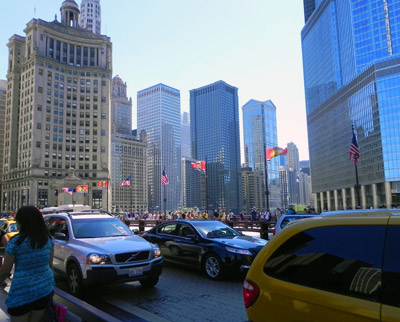Balbo Drive

Back to Balbo Drive
Back to Balbo Drive
For when it rains...
Downtown Chicago is a series of rooftops, parking lots, roads, sidewalks, and other surfaces that cannot absorb water. When it rains, water flows across these hard surfaces and pours into the Chicago River, Lake Michigan, or city sewers that eventually empty into both during heavy storms.
Stormwater runoff is one of the biggest culprits in lake and river pollution. When it flows into nearby waterways, runoff brings everything with it – from gasoline and trash on city streets to fertilizers and pesticides from lawns. These pollutants degrade water quality, raise water temperatures, and spur algae growth. As you might imagine, pollutants are also bad for fish. They clog gills, decrease resistance to disease, and suffocate eggs and newly hatched larvae. Bacteria carried in runoff can also make swimming in the lake a health risk. Stormwater runoff is behind most of the swim advisories and beach closures that plague the Great Lakes region each summer.
Concerns about stormwater pollution are on the rise as storms get bigger. During 2007-2013, the city's sanitation district was forced to release nearly 32 billion gallons of contaminated water into Lake Michigan, largely because of a handfull of monsoon-like storms that flooded the city.
Stormwater runoff is one of the biggest culprits in lake and river pollution. When it flows into nearby waterways, runoff brings everything with it – from gasoline and trash on city streets to fertilizers and pesticides from lawns. These pollutants degrade water quality, raise water temperatures, and spur algae growth. As you might imagine, pollutants are also bad for fish. They clog gills, decrease resistance to disease, and suffocate eggs and newly hatched larvae. Bacteria carried in runoff can also make swimming in the lake a health risk. Stormwater runoff is behind most of the swim advisories and beach closures that plague the Great Lakes region each summer.
Concerns about stormwater pollution are on the rise as storms get bigger. During 2007-2013, the city's sanitation district was forced to release nearly 32 billion gallons of contaminated water into Lake Michigan, largely because of a handfull of monsoon-like storms that flooded the city.
